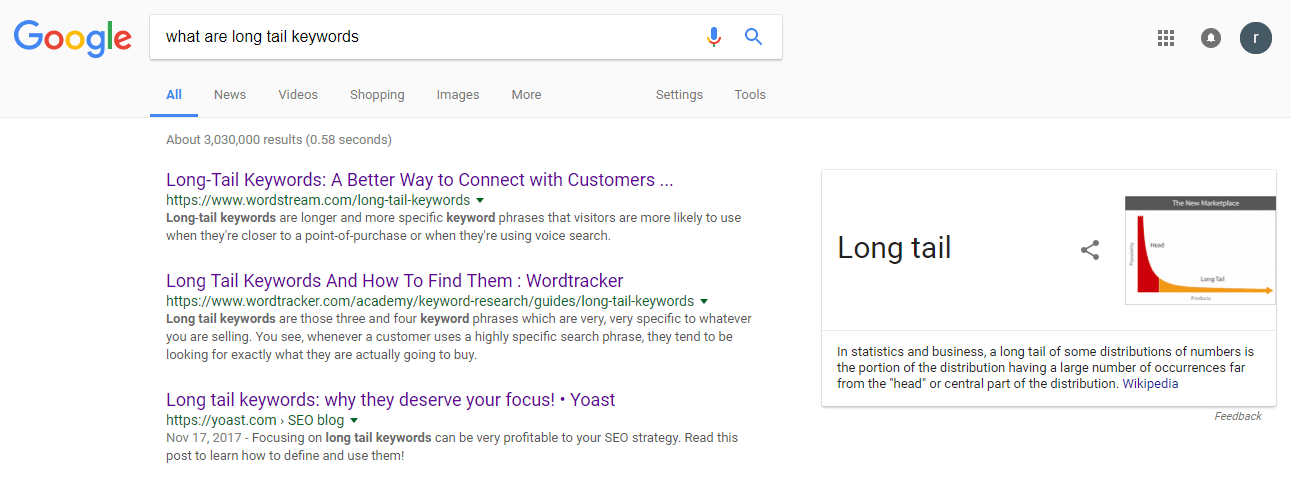You probably know how important keywords are to your website. They’re a crucial part of any Search Engine Optimization (SEO) strategy, helping you rank higher on sites like Google. However, you may not know that a distinction can be made between short-tail and long-tail keywords.
This difference is important, because while many sites exclusively target the big ticket short-tail keywords, focusing on their longer cousins can be a more viable strategy. Long-tail keywords are more precise, so they’re better able to attract your target audience. Plus, you’ll face less competition when trying to rank highly with them.
What long-tail keywords are
Keywords are words or phrases you use within your online content to improve its Search Engine Optimization (SEO). A strong keyword needs to be a close match to a term someone would type into a search engine. A person looking for advice on their new dog might enter “dog care” into Google, so that’s a keyword you could incorporate into a blog post about the same subject.
“Dog care” is an example of a traditional, short-tail keyword. It’s broad enough to apply to many Google searchers. Most short-tail keywords are one or two words long, such as “fitness” or “used cars”.

Understanding what people search for online is key to getting your content noticed.
In contrast, a long-tail keyword is usually three or more words long, often capping out at five or six words.
So instead of targeting “dog care”, your blog post could use the keyword “how to care for a dog”. Other examples of long-tail keywords might include “how to improve my fitness” and “find used cars nearby”. Despite what seems like a small difference, there are some compelling reasons to use this type of keyword.
Why you should start using long-tail keywords
Traditionally, most SEO advice has focused on short-tail keywords. These keywords give you access to the widest audience, since short keywords nearly always have a higher search volume. While “cook pasta” might have a hundred thousand daily searches, “how to cook homemade pasta” might only have ten thousand.
However, long-tail keywords have their own unique advantages:
- They’re more descriptive, and tell people more about your content’s topic. So while you’re targeting a smaller pool, it’s made up of people who are more likely to be interested.
- There’s less competition for longer keywords. This means you don’t have to fight for views with hundreds of established websites.
- You’ll often see SEO benefits, since long-tail keywords help search engine bots recommend your content to the right people.
- Long-tail keywords are often easier to work into your content naturally.

Longer keywords tend to have lower search volumes and less competition.
Of course, this isn’t an either-or choice. There’s no reason you can’t target both long and short keywords on your site. Long-tail keywords are increasingly proving their effectiveness, however, so now is the time to start using them.
Where to start looking for long-tail keywords
It’s always smart to develop your keywords through research. That way, you can find phrases people are actually searching for. The simplest way to start generating some long-tail keyword ideas is to use the Google search engine itself.
You’ve probably noticed that Google suggests alternative keywords to searchers. These suggestions are based on real queries, so they’re excellent options for you to use. Start by typing in a few words describing the topic you need a keyword for. In most cases, Google will immediately provide a list of options:
If you scroll down to the bottom of the page, you’ll also see a section listing related searches:
Both places are perfect for spotting longer, more specific keywords that Google users are actually searching for. You can also use a dedicated research tool, such as the Google Keyword Planner. This is a free resource that will show you the search volume and competition level for just about any keyword.

The Google Keyword Planner provides useful information about keyword analytics.
Another good tool to help you find longtail keywords is KWFinder. It gives you three different methods of uncovering longtail keywords that people search for.
Regardless of where you go, you’ll want to look for keywords that have low competition, but still offer a decent search volume. You’ll also want to focus on those you can work naturally into your content. Ultimately, finding strong long-tail keywords isn’t any harder than doing the same with shorter keywords. Just remember to stick with phrases that are at least three words long.
How to use long-tail keywords effectively
Once you have a long-tail keyword to target, you simply need to incorporate it into your content. The process isn’t much different than using short-tail keywords, so if you have some SEO experience you should know what to do.
All the same, here is the general process you’ll want to follow when using long-tail keywords:
- Start by finding a keyword and writing content based on it, instead of the other way around. That way, you know you have a built-in audience. You’ll also want to choose a different keyword for each major piece of content (such as a page or blog post).
- Incorporate the keyword into multiple places, but be careful not to overuse it. Long-tail keywords tend to stand out more, and readers might catch on if you use it every other paragraph. Try to use it in the title, at least one header, the first paragraph, and occasionally throughout the text.
- Make sure you’re using the keyword naturally, rather than stuffing it into sentences where it doesn’t belong.
- Add the keyword to other crucial places, such as your content’s meta description and your images’ alt text.
Finally, don’t forget to track your keywords’ performance! The information you get will help you make better choices over time, so you can be confident that you’re targeting the best long-tail keyword options.
Conclusion
Competition is fierce for many of the most popular keywords used in online searches. Therefore, it can be smart to focus your efforts on longer, more specific phrases. The pool of searchers you’re targeting will be smaller, but you’re likely to attract a lot more of them if you use long-tail keywords effectively.
To find long-tail keywords to use in your content, you can start by checking out Google’s suggested and related searches. The Google Keyword Planner will also be an invaluable tool. Then you can incorporate your new keywords into your content. Just remember to use them naturally, and follow the usual SEO best practices.






















Or start the conversation in our Facebook group for WordPress professionals. Find answers, share tips, and get help from other WordPress experts. Join now (it’s free)!